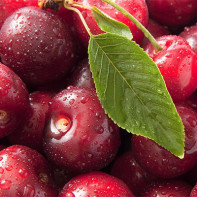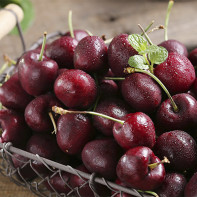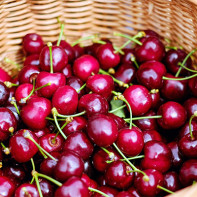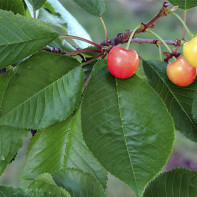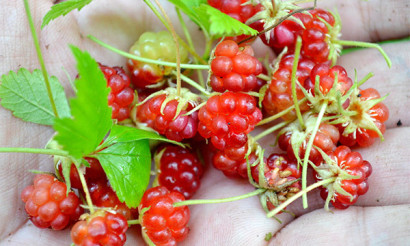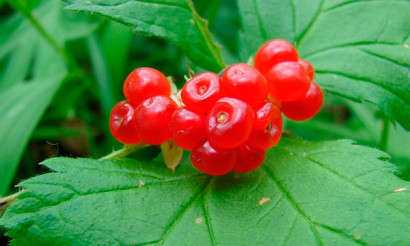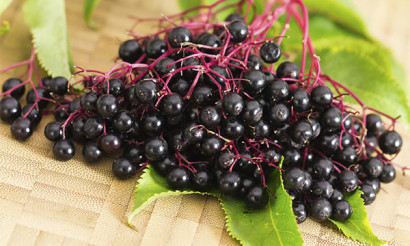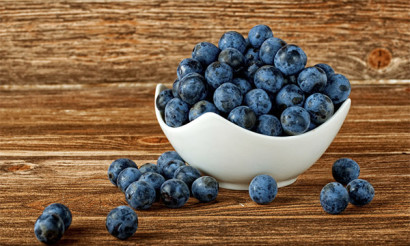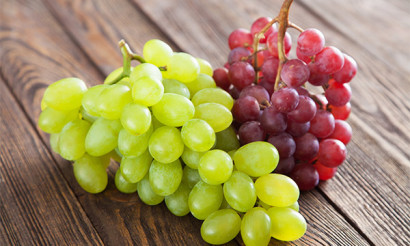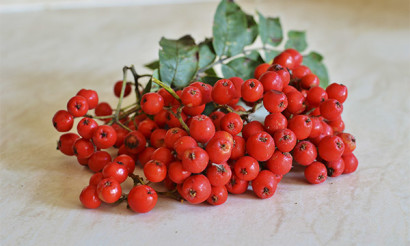Cherry: useful properties and contraindications
Cherries are sometimes called a sweet cure. Indeed, it contains a lot of useful substances - vitamins, minerals, anthocyanins that help improve the condition of blood vessels and joints.
- What is the difference between a cherry and a cherry
- What is more useful: cherry or cherry
- How many cherries can be eaten per day
- Can I eat cherries at night?
- Composition and calories
- What are the benefits of cherries
- General benefits
- For Women
- For Men
- When pregnant
- For breastfeeding
- For children
- Slimming
- Cherry Leaf and Cherry Seed Benefits
- Dried and Frozen Cherry
- Cherry in Medicine
- Diabetes Mellitus
- For pancreatitis
- For Gastritis
- For Intestines
- For constipation
- For gout
- Cherry in cosmetology
- Harm and Contraindications
- Symptoms of cherry allergy
- How to choose and store cherries
- Can I freeze cherries?
- What can be cooked from sweet cherry: Recipes
- Jam
- Compote
- Wine
- Is it possible to give animals sweet cherries
- Interesting Facts about Cherry
What is the difference between cherry and cherry
Cherry and cherry trees are very similar to each other. From a botanical point of view, this is quite understandable. After all, both trees belong to the same family of Rosaceae. And the fact that they are biologically related has been known to gardeners since ancient times, long before the appearance of genetics. So nowadays, most of the modern varieties are the result of crossing cherries and cherry trees. Even today, however, both the trees themselves and their fruits differ from each other.
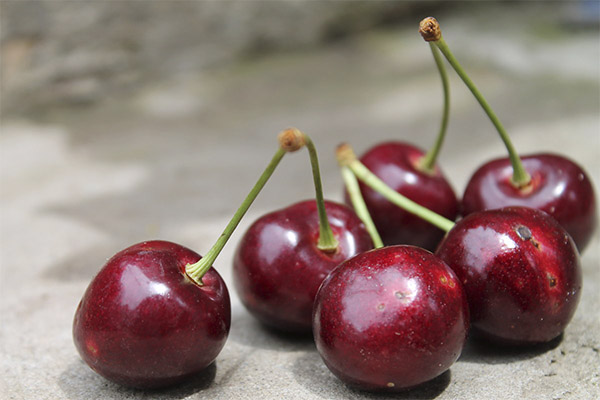
First of all, you have to learn to distinguish whether you are looking at a cherry tree or a sweet cherry tree, because they are also very similar. Cherry trees have brown bark with a more intense hue, small, bright green leaves, a spherical crown and a root system that can be horizontal or vertical. Cherry trees have lighter bark, which may be silver or slightly reddish in color. The root system can only be horizontal, and the crown is more elongated, egg-shaped.
But, of course, the main difference is the fruit itself. Cherries in cherries come in only red hues, always very juicy, but slightly sour. This sourness persists even in jam. The cherry fruit tends to be larger. They can come in various shades: yellow, red, pink, and almost black. It is recommended to dry or freeze them for the winter, since jam often turns out to be sugary sweet.
Which is healthier: cherries or sweet cherry?
Both berries have a similar chemical composition, but not identical completely. Nutritionists claim that cherries have a much richer mineral composition, and the fruit contains fewer carbohydrates than cherries. But in fact their glycemic index is not much different, the cherry has 22 units and the cherry has 25. The energy value is also almost the same. So in case of diabetes the cherry is considered more useful, but it is not necessary to refuse cherries altogether.
In addition, the cherry fruit contains more of the hormone melatonin, which is necessary for the normal functioning of the endocrine system and reducing the level of bad cholesterol. That is why it is recommended to eat cherries for people suffering from thyroid diseases. But cherries contain substances that can fight inflammation and joint pain. Therefore, they are recommended as a healthier product for arthritis and gout.
How many cherries can be eaten per day
Doctors, despite all the benefits of cherries, recommend not to get carried away with this product. The maximum amount of fresh cherries - 300 g at one meal and not more than 1 kg per day. Otherwise they can cause digestive problems up to severe diarrhea. In order to minimize the unpleasant consequences you should eat cherries as a separate dish for a snack or as a dessert not earlier than 30 minutes after the main meal.
Of course, you can use only quality product, and to determine the degree of maturity of the berries can be judged by the color of the stalk. It should be green, but if it is brown, then the cherry is overripe, and this product is not very useful.
Can I eat them at night?
Many people think that since you can't eat heavy dishes for dinner, you should replace them with berries, such as cherries. But in fact, this is not quite true, because this fruit has a slight laxative and diuretic effect, and the night can be restless. On the other hand, if you eat 5-10 berries, nothing bad will happen.
It is best to eat cherries for breakfast or an afternoon snack. Many people think that this is not a good idea, because there will not be enough protein in such a meal. In fact, you can supplement the berries with low-fat cottage cheese or yogurt, cheese or a handful of nuts. Then this will saturate the dish with protein and the carbohydrates will be absorbed more slowly, keeping blood sugar levels at the same level.
Composition and calories
The energy value of cherries is only 52-62 kcal per 100 grams, depending on the variety. And it contains the most water (82-85.7 g) and carbohydrates - 10.6-16 g. The rest are proteins, fats (together - just over 1%) and a number of useful substances, which will be discussed below. In particular, cherries contain:
- Anthocyanins (250 mg per 100 g) - substances from the group of flavonoids. On the one hand, they are responsible for the red and purple color of berries. Yellow cherries practically do not contain them. On the other hand, they have anti-inflammatory properties, are responsible for the barrier function of the intestine, which helps prevent serious diseases.
- Coumarins are substances that have antispasmodic and anticancer effects.
- Carbohydrates are glucose and fructose. At the same time, 75% of the carbohydrates is fructose, which is easily and without harmful consequences assimilated by the body. Therefore, these berries can be consumed even by those who suffer from diabetes (of course, in small quantities). Fructose has been proven to improve the function of the pancreas.
- Pectins - normalize digestion, improve intestinal function.
- Vitamin C (15 mg) - is responsible for blood circulation.
- Vitamin PP - good for vision.
- Tocopherol (or vitamin E - 0.3 mg) - an antioxidant.
- B vitamins - normalize the nervous system and speed up metabolism.
- Iron (1.8 mg, or 10% of the daily requirement) - this element is necessary for the normal functioning of the hematopoietic system.
- Potassium (233 mg, more than 9% of the daily requirement) is necessary for normalizing blood pressure and strengthening heart muscle.
- Calcium (33 mg) - is needed to strengthen blood vessels.
- Magnesium (24 mg) - has an antispasmodic effect.
- Phosphorus (28 mg) - needed for normal metabolism, improves cognitive function.
Thus, thanks to the vitamin composition of cherries will be useful for people suffering from iron deficiency anemia, diseases of the musculoskeletal system, dermatological diseases.
What are the benefits of cherries
General benefits
Although the chemical composition of different types of cherries may differ slightly, in fact, they are all equally useful.
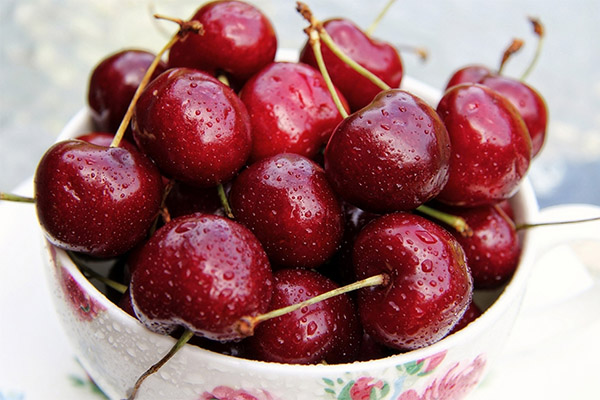
- The pigment melanin in cherries protects the skin from the aggressive effects of the sun and prevents the development of cancer. So the residents of southern regions are recommended as often as possible to snack on these berries, observing, of course, a reasonable moderation in terms of portion size.
- The flesh of berries contains a lot of copper, which stimulates the active formation of collagen protein that provides elasticity and firmness of the skin, which prolongs its youth.
- Cherries should be consumed by anyone who has experienced cardiovascular diseases. Coumarins, anthocyanins, and vitamins help strengthen not only heart muscles and large vessels, but also capillaries. In addition, coumarins can help reduce blood clotting, and this prevents the formation of blood clots, so that cherries are an excellent preventive measure against heart attacks and strokes.
- The abundance of soluble fiber, which has a mild laxative effect, makes cherries an excellent cure for constipation, not only effective, but also very tasty.
- Cherries contain a lot of vitamin C. Scientists are still debating how important a role it plays in the formation of the immune system. However, it is absolutely known that it improves the absorption of iron. So it is worth to eat cherries vegetarians, as well as people who adhere to strict diets, because in the absence of meat in the diet the risk of anemia is seriously increased.
For women
For the fair sex, cherries are useful for several reasons.
First of all, they contain substances which allow stabilizing the hormonal background, which has a favorable effect on the menstrual cycle and makes the process less painful.
Secondly, the consumption of cherries helps to prevent the formation of blood clots, which could later form blood clots. This problem is most often faced by women who have been using hormonal contraceptives in the form of pills for a long time.
In addition, blood thinning is very important for menopausal women, so they will also benefit from cherries. It also contains a lot of tocopherol (that is, vitamin E), which is an antioxidant and ensures the beauty and youthfulness of the skin.
For men
For the stronger sex, cherries are useful because they help reduce bad cholesterol levels, a problem most often faced by men. Thus, the regular consumption of fresh, dried or frozen cherries can prevent cardiovascular disease.
In addition, anthocyanins and antioxidants contained in cherries prevent the development of prostate tumors. Also, this berry has a positive effect on the production of male sex hormones. Doctors recommend men to eat at least 100 g of cherries every day to prevent erectile dysfunction.
This berry will be useful to those who are actively engaged in sports. It is believed that it not only gives energy and helps to restore strength, but also prevents muscle pain that can occur after an active workout. And for all these purposes, it is better to use darker varieties of cherries, which contain more substances that have a positive effect on the heart and blood vessels.
When pregnant
Cherries are very useful to future mothers. They contain beta-carotene and vitamin A. These substances provide renewal of skin cells, mucous membranes, hair and nails, the condition of which often suffers during pregnancy. Cherry also contains B vitamins, which are necessary for normal metabolic processes, and in fact it is very important for future moms to maintain optimal weight, otherwise edema will be inevitable. In addition, these vitamins normalize the work of the nervous system, which allows the woman to get rid of anxiety and irritability, as well as mood swings, especially frequent in the first trimester.
Vitamin PP is necessary for cell respiration, so the fetus gets enough oxygen, it helps prevent hypoxia with its dangerous consequences for the baby. Ascorbic acid in pregnancy is needed not only to strengthen the immune system, but also to cope with rapid fatigue - a problem associated with hormonal restructuring of the body, faced by many women.
Cherry fruits with their mild diuretic action stimulate the kidneys, removing excess fluid - its stagnation during pregnancy is explained by the fact that the load on this organ is greatly increased. Anthocyanins and coumarins help normalize blood pressure, while in the second and third trimesters, many women face a rise in blood pressure due to increased blood volume in the body.
Fiber with its mild laxative effect does not affect uterine tone, but at the same time helps to easily cope with constipation, which plagues many expectant mothers.
Finally, in the early term cherries help with bouts of morning sickness. But for such a result you need to eat literally 3-4 berries, just to have no attacks of hunger or gagging. Sometimes these berries even help to cope with headaches in the early stages of pregnancy.
Ripe cherry fruits contain many vitamins, organic acids and minerals. This composition:
- beneficial to the formation of the placenta and fetal development;
- Prevents anemia;
- Provides cleansing of the body of toxins;
- Prevents and treats varicose veins;
- Strengthens the bones of the fetus;
- Improves cardiac activity;
- stimulates collagen production and prevents stretch marks.
Of course, all this applies when the future mother is not allergic to cherries. In order not to risk it, you can replace the red berries with yellow ones - they do not cause a similar reaction. In any case, before the inclusion of berries in the diet, it is necessary to consult with your doctor.
When breastfeeding
Young children are very sensitive to the mother's diet, their own digestive system is still only being formed, and allergic reactions may occur even when using relatively innocuous products. So until the baby is two months old, cherries should be removed from the diet of the young mother. However, later it will bring only good.
- The B vitamins it contains normalize the nervous system, help stabilize the emotional state and prevent postpartum depression.
- Antioxidants and minerals in the composition of the berry will help improve the condition of the skin, hair and nails.
- In addition, cherries normalize digestive processes and speed up metabolism, which allows you to get rid of extra pounds that women gain during pregnancy.
However, it is necessary to consume cherries in reasonable quantities, looking closely at the reaction of the baby to this product. First you should try to drink 1 tbsp of cherry juice. If the baby will not be allergic and there will be no colic, you can eat a few berries and check the baby's reaction again.
For a nursing mother, the maximum amount of cherries is 300 g per day.
For children
The benefits of cherries for children's bodies are indisputable. And every year, scientists and researchers continue to discover more and more properties of this amazing berry. For children, it is useful because it allows you to strengthen the natural immunity without taking pharmaceutical drugs. Anthocyanins and other substances that make up the cherry activate the fight against inflammatory processes. They also protect the body from cancer.
Cherries improve a child's appetite, strengthens the walls of blood vessels, and normalizes the nervous system. Its regular use promotes good sleep.
However, babies should not be in a hurry to give cherries. The fact is that berries contain allergens. So until the baby is a year old, we do not need to give him a cherry, even if there are no prerequisites for an allergic reaction, and neither parent in childhood was not allergic to this product.
Berries are introduced into the diet gradually and only in season, so that it was mature, from local varieties. At first give just a few berries, as a larger amount can cause increased gas and bloating of the stomach. If there are preconditions for an allergic reaction, then give yellow cherries, not red. The fruits should be firm, shiny, without a single spot, and their tails should be green. It is recommended before buying berries to break a couple to check if there are no worms.
For losing weight
Almost all varieties of cherries - yellow, pink, red - are equally useful for weight loss. Although the darker varieties contain more fruit sugars, they will still help you lose excess weight and are good for your skin because they contain anthocyanins. Yellow cherries contain more water, their caloric content is lower, and they allow you to get rid of excess weight and swelling faster.
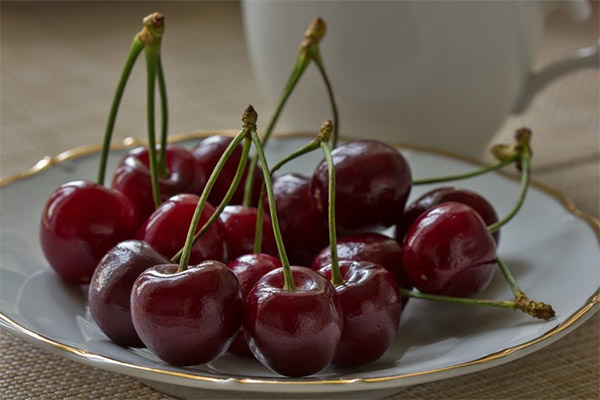
The cherry diet is good because with this berry the body gets almost everything it needs, including a rich set of vitamins and minerals (not to mention plenty of iron). At the same time on hot summer days cherries are well satiated, a person does not have a feeling of hunger, which could lead to a breakdown of the diet. Psychologically such a diet is very well tolerated. Only you need to remember that a day on such a diet can't eat more than 450-500 grams of cherries. And this amount should be divided into equal portions, and not eaten all at once, so as not to harm the gastrointestinal tract. You can also drink cherry compote, cooked without sugar.
Like all mono diets, this diet requires prior consultation with your doctor. In any case, it cannot be adhered to for more than seven days. But during this time you can get rid of 4-5 kilograms of extra weight.
The menu of the cherry diet will be as follows:
- For breakfast eat only 250 g of cherries and drink a glass of green tea.
- For lunch - 100 g of boiled or steamed chicken or turkey fillet. You can replace poultry with low-fat fish, but cooked in the same way. For dessert - a glass of cherry compote.
- Afternoon snack - 200 g of cherries.
- Dinner - another 100 g of poultry or fish (depending on what was for dinner). To this you can add another 40-50 grams of salad made of leafy vegetables.
Before going to bed it is recommended to drink half a glass of natural yogurt. No more is necessary, as cherries contain enough fiber to normalize the digestive process.
The benefits of cherry leaves and seeds
Not only are cherries useful, but also their leaves, stalks and pips. So, from the leaves are prepared decoction, which has antiseptic properties (1 tbsp. dry crushed raw material per glass of boiling water). This decoction is recommended to add to foot baths, which serve to prevent and treat foot fungus.
The stalks of cherries contain a substance amygdalin. It has a calming effect on the nervous system. Recommended to make a decoction from the stalks (1 tbsp. raw material in a glass of boiling water) and drink it in the morning and evening to not suffer the effects of stress in the form of a feeling of anxiety and irritability.
Amygdalin is also contained in the seeds of cherries. They also contain useful essential oils and fatty acids. It is believed that the decoction of the pips is worth consuming in case of kidney disease, because it has a mild diuretic effect.
The benefits of dried and frozen cherries
Dried and dried cherries largely retain the useful properties of fresh berries. But there are certain nuances. If fresh cherries have a slight laxative effect, then just dried has a hardening effect.
Dried berries are added to baked goods, compotes, jellies. In the winter time it is a good opportunity to vitaminize the body, because in the natural drying process the useful substances are practically not destroyed.
With proper freezing (and if stored properly) cherries and in this form retains its useful properties. Of course there is a slight decrease in nutritional value, but it can be considered negligible, because mainly not the most useful substances are destroyed. But the fat-soluble and water-soluble vitamins in berries remain. That is, frozen cherries still contain retinol, ascorbic acid and B vitamins.
But, from a certain point of view, frozen berries have some advantages over fresh berries. They contain fewer pesticides. Not to mention the fact that these cherries are much tastier than those out-of-season fresh berries that are sold in winter in supermarkets.
Cherry in medicine
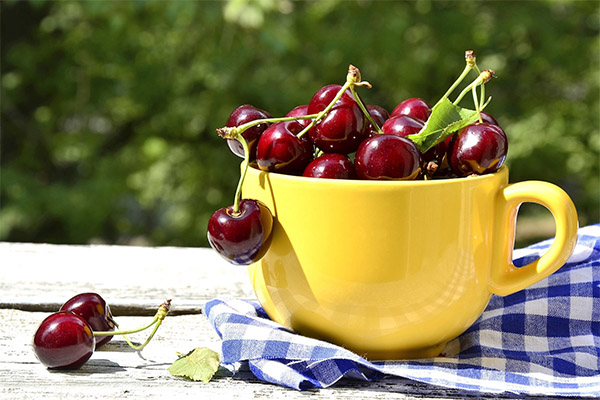
In official medicine cherry is not considered a medicine. Nevertheless, its benefits have been proven by numerous clinical studies. In particular, it is known that the regular consumption of these berries:
- allows you to normalize blood pressure;
- reduces the risk of blood clots;
- reduces the level of bad cholesterol;
- increases natural immunity;
- Serves as a prophylactic of viral and colds;
- normalizes the digestive process.
In addition, cherries are a beauty product. It contains many useful substances that can improve the condition of the skin, hair and nails.
In case of diabetes
Although cherries contain glucose, in fact, the percentage of harmful sugars in these berries is relatively low. At the same time, cherries have a low glycemic index (only 25 units). Therefore, if you have diabetes, these berries can and should be included in your diet, but only in fresh form, no jam, jelly or compote. A day you can eat no more than a handful of berries, whether yellow or red.
Cherries, thanks to their anthocyanin content, can eliminate complications from diabetes, including those related to heart disease, and even prevent the development of malignant tumors.
In pancreatitis
With an exacerbation of pancreatitis, the patient is forced to follow a very strict diet, so any fresh fruit is out of the question. Approximately on the 4-5th day from the beginning of the exacerbation, berry compotes and kissels are introduced into the diet, they can also be made from cherries, especially since it contains less acid than cherries. In about 1-2 weeks from the time of the exacerbation you can make jellies and mousses of cherries.
In stable remission of chronic pancreatitis you can also eat cherries fresh. The season should start with 1-2 berries a day. The maximum amount of cherries, which can be eaten per day in this disease is 100 grams (about half a cup).
Gastritis
In this disease, the scheme of consumption of cherries will be about the same as for pancreatitis. In the acute stage, when any fresh fruit is contraindicated, it will have to be abandoned. Then, these berries are used to make compotes and kissels without added sugar, to make jellies and puddings. And if there is a stable remission, you can safely include fresh berries in your diet, because they do not cause heartburn and do not increase the acidity of the gastric juice.
Those who often suffer from constipation will also benefit from the use of cherries and cherries. It is allowed to drink juice made from these berries. But if the acidity of the stomach is increased, then the experts recommend giving up on cherries. But cherries are allowed to have in their diet, even those who have gastritis and stomach ulcers. The fact is that, unlike cherries, this sweet berry never increases the acidity of gastric juice and does not provoke the appearance of heartburn.
For the gut
Unlike cherries, cherries contain few acids. They practically do not irritate the intestinal mucosa, so it can be eaten even with peptic ulcer (but not during the acute phase, but in remission).
In irritable bowel syndrome, which is accompanied by diarrhea, dried cherries will help. To do this, take 30 grams of raw materials, pour a glass of cold water and insist all night. Take a little infusion, dividing the entire volume into 3-4 servings.
When constipation
Much, of course, depends on the cause of constipation. But if they are caused by atony of the intestine, a decrease in its motor activity, it is sufficient to simply use 150-200 grams of fresh cherries a day, and the result will appear immediately. Some doctors recommend using this sweet medicine for a course of 1-2 weeks, but, in fact, that's how long the season of cherries lasts.
In case of gout
Gout is a disease associated with inflammation of the joints caused by disorders of salt metabolism. Since cherries do not contain purines, which lead to such a violation, it is possible and even necessary to eat them in this disease, as it reduces the pain in the joints and helps to relieve inflammation.
In this case you can eat cherries fresh (100-300 grams per day, depending on tolerance). But other remedies also work well, such as infusion of pips, which is drunk as a course of two weeks. You can also drink decoction of the stalks (tails) of cherries. This is done by taking 1 liter of water, bringing it to a boil and throwing 4 tablespoons of stalks. The broth is boiled over low heat for 3-5 minutes, then leave until it cools and strain. A day you need to slowly drink up to 0.5 liters of broth.
Cherry in cosmetology
Because cherries contain a lot of vitamins and minerals, they are used for summer face masks. Both ripe and unripe berries are used: they contain less sugar, but they contain enough vitamins.

You can do the following masks:
- To narrow pores. To do this, take 100 grams of unripe berries, remove the seeds, crush, the resulting mass is applied to the face, neck and decollete for 12-15 minutes, then wash off and apply day moisturizer.
- For dry skin. For this you will need yellow cherries - 5-6 chopped berries, which are mixed with a spoonful of olive oil and applied to the skin for 15 minutes and then washed off with water.
- For oily skin - 7-8 red cherry berries are crushed, 1 tsp. freshly squeezed lemon juice is added and applied to the skin for 20 minutes, then washed off. Lemon also has a whitening effect.
Cherry juice can be added to wash water - it is good for all skin types.
Health and contraindications
Cherries have practically no contraindications. However, fresh berries should not be consumed if you are prone to diarrhea, increased gas and flatulence. With caution should be included in the diet of those people who suffer from obesity or diabetes - not more than the medical standard.
Fresh berries should not be consumed in the presence of allergies, as well as in the presence of an acute form of gastritis, peptic ulcer or colitis.
Symptoms of allergy to cherries
As a rule, an allergic reaction is accompanied by characteristic signs of this disease - the appearance of a red rash and itching. In some cases, more severe manifestations of hives are possible, when it covers not only the skin, but also the mucous membranes, leading to their swelling, which is accompanied, among other things, by a cough and runny nose with transparent secretions. Cherry allergies can also lead to digestive disorders - diarrhea or bloating.
How to choose and store cherries
In order to benefit from the use of cherries, you need to choose the right berries. They should be ripe but not overripe - firm, glossy, without spots. The stalks should be green and fresh.
But even such berries can't be stored for a long time. A little longer freshness will help storage in a well washed and dried glass jar, on the bottom of which should be placed clean cherry leaves. Pour the washed berries, stirring them with layers of leaves. Then cover the jar with a plastic lid. The berries can stand this way for several weeks.
To store in the winter, the cherries can be dried - either in a special dryer or the classic way. In the latter case it should be blanched for 5-8 minutes in hot water, then immediately lowered into cold water, and then spread out in a single layer in a fairly large sieve. After that the cherries should be slightly jammed in the oven at 65 degrees, and then dried by increasing the temperature to 85 degrees.
Can I Freeze
Cherries can be frozen. This will help preserve all the useful substances. You just need to follow certain rules for the preparation of berries and their further storage. To begin with, it should be noted that the berries must be ripe, not spoiled, without any dubious spots. Preliminarily it is necessary to remove the leaves and stalks. Act very carefully, so as not to damage the berries in the processing. Some delicate varieties are better to freeze directly with stalks, and peel them after defrosting. Ideally, it is better to take only the ones that were picked two hours before you send them to the freezer, but this is only possible in your own garden.
The cherries must be washed by all means. Then dry them on paper towels, distributing them evenly in a single layer. Put another towel on top, so that they absorb the moisture faster.
To store frozen cherries, use both the special resealable plastic bags that are sold in supermarkets and the usual plastic food containers. Do not use already used bags, as they may have a strange smell, in addition, they may have tiny holes, so that the berries will depressurize, and ice can get into them. Glass containers are not suitable, in the cold it can crack.
As already noted, before freezing the cherries should be thoroughly washed and dried. If it will be used for compote in winter, it is not necessary to take out the pips. If, however, the berries are intended for stuffing dumplings or pies, then the pips should be taken out.
Cherries should be frozen in a quick freezer by spreading them out in a single layer on polyethylene. Then you can put them in bags. Then the berries will remain intact. Putting cherries in bags or boxes, you need to take care that the berries lie fairly tightly. The air should be let out as much as possible. If the container is opaque, you should make a record of its contents and put the date of freezing, so as not to open it unnecessarily.
Cherries can also be frozen with sugar. To do this, the berries should be placed in plastic containers in layers, pouring sugar over them. Keep such a dessert should be in the freezer.
Frozen cherries should not be kept near any other strong-smelling products, otherwise the smell will be absorbed. It is best to freeze berries in small portions, placing them in special bags to defrost as needed.
What can be cooked from sweet cherries: Recipes
From cherries are made compotes, jam (although rarely), make fillings for pies, added to fruit salads and smoothies. In short, everything depends solely on the imagination of the hostess.
Jam
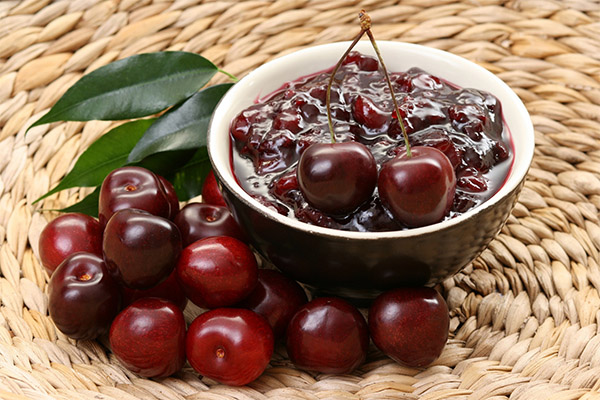
You will need:
- Cherries - 1 kg.
- Sugar - 1 kg.
- Water - 1 cup.
- Vanilla sugar - 5 grams.
- Citric acid - 1 tsp.
Unfortunately, it is impossible to make jam from cherries quickly, because the sugar simply does not have time to be absorbed into the resilient berries. For this reason, the sweetness is usually cooked in several stages:
- The berries are first cleaned from the stalks and thoroughly washed. Then they are placed in a container (the best is to use an enamel bowl) and immediately they are poured with sugar syrup, then left for 4-12 hours so that they soak.
- Then the sweet mass is boiled again for 3-5 minutes and infused for 5-8 hours. Important point: during boiling be sure to remove the foam.
- At the end of the second cooking put a pinch of vanilla sugar and citric acid.
- Pour the jam on dry sterile jars, filling to 1/2 cm below the top of the neck.
Compote .
This is one of the most delicious summer drinks, but most often it is one of the ways to make berries for the winter. For 4-5 cups of cherries take 1.5 cups of sugar, 3 liters of water, lemon juice and vanillin to taste.
Process:
- The berries are sorted out, washed, jars are sterilized, at the same time bring the water to a boil.
- Ready to fill jars with berries, pour boiling water, cover and leave for 15-20 minutes.
- Then the water is poured back into the pan, add sugar and lemon juice and vanilla, and again bring to a boil.
- The berries remaining in the jars, again pour the syrup and immediately roll up. After this, they are turned upside down and covered with a towel.
Wine
In southern countries, cherries are used to make wine - a pleasant light drink that can be made at home.
For this purpose, for 10 kg of berries take 1 kg of sugar, 0.5 liters of water and 25 grams of citric acid. The latter is needed in order to remove excessive sweetness, it also serves as a stabilizer and increases the shelf life. Lovers of sweet wines can add another glass of sugar.
Some experts advise not to wash the cherries, but just wipe them with a dry rag so that the wort ferments faster. But this is only if we are talking about ecologically pure product, for which there is confidence that it has not been treated in any way. If there is no such assurance, it is better to wash the berries. Then proceed as follows:
- Remove the pips from the berries with the utmost care, trying to make sure that the juice goes where the pulp does. Pips contain poisonous substances and give an unpleasant bitter taste.
- Water is added to the berries, stirred. All this is shifted into a vessel with a neck tied with gauze, and leave for 2-3 days in a dark place. Keep the container in the cold it is not necessary, room temperature will be just fine. On the surface will appear a kind of "hat" of skin and pieces of pulp. It can be knocked down with a wooden spatula.
- As soon as foam and a slight sour smell appear, the juice is filtered through gauze into a new container, filling it 2/3 full. The remaining pulp (skin and pulp) is properly squeezed.
- Add citric acid and 2 cups of sugar, mix and put on a container or ready-made water trap, or an ordinary medical glove, one of the fingers of which is a hole. The vessel is kept in a dark room at room temperature.
- After 4 days, remove the odor trap, the must of 1 liter poured into a separate container, add a cup and a half of sugar. The syrup is obtained, which is poured back into the container, and it is again put hydroshutter. After three days, the procedure of making and draining the syrup is repeated, which takes the remaining sugar.
- In about a month the wine will lighten, a sediment will form at the bottom of the container, this is normal. Since the gas is no longer released, the gauntlet of the odour trap will deflate. The wine is poured through a thin tube, which is used for drips, into a prepared container.
If desired, you can add sugar to the wine again or make it stronger by adding vodka (but no more than 10% of the finished volume). The container, intended for storage, should be tightly closed. If sugar has been added, you need to put a water seal for another week. Once in three weeks it is recommended to remove the wine from the sediment. If there is no sediment, then the drink is ready.
Is it possible to give pets cherries
Modern cat and dog food contains all the necessary vitamins, so there is no particular benefit in cherries for animals. But also call it unequivocally prohibited product. From time to time, if the pet likes cherries, he can be given a couple of berries, but be sure to peel them from the skin and take out the bone.
Interesting facts about cherries
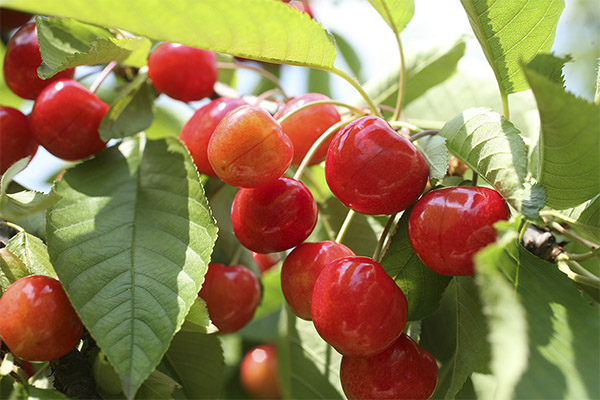
- Cherry trees grow in all southern regions of Europe. They can grow to a height of 25-30 meters - science has recorded such cases. From one average tree, bees can collect 35 kg of pollen.
- There are many varieties of cherries, and in some of them the berries can reach 2 cm in diameter. Currently there are about 15-20 varieties of sweet cherry actively cultivated in the world.
- In England, sweet cherries are called sweet cherries, emphasizing the similarity between the two berries. But in many other languages the name "bird cherry" has caught on. The fact is that birds like ripe cherries much more than they like cherries. Sometimes whole flocks of sparrows or rooks literally swarm the tree and peck all the berries.
- The cherry tree is considered more fragrant. But the resin of the cherry tree contains carbohydrates. It was once used as gum.
- The color of the cherry tree is due to the content of anthocyanins. The more of them, the darker the color and the higher the degree of ripeness. But the amount of sugar also increases proportionately. Interestingly, cherries are used to make a food coloring, but they do not produce a red color, but a green one.
- Although cherries and cherries are very similar, they did not appear at the same time. The first cherry was still the cherry, and it became the ancestor of the cherry, as genetic research has shown. At the same time cherry has been known to people for over ten thousand years, but because it is very heat-loving, it often does not take root in harsher conditions. Even in the middle belt of Russia you will not find it, although cherries grow excellently in this region.
«Important: all the information on the site is provided solely for introductory purposes only. Before applying any recommendations, please consult with a specialized specialist before using any of the recommendations. Neither the editors nor the authors shall be held liable for any possible harm caused by materials."

